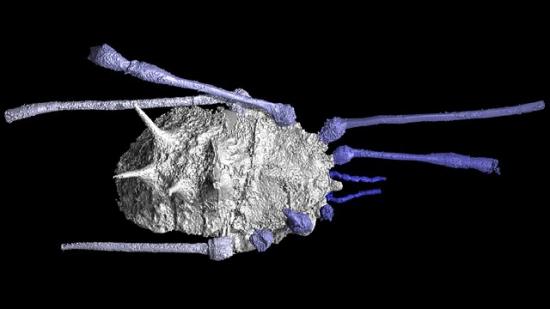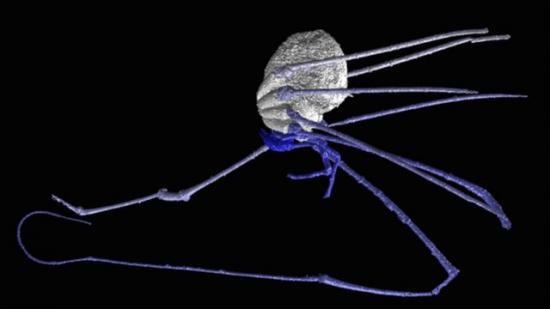
带刺的机体可威慑捕食者
盲蜘已经存活了数亿年,另人惊奇的是在那么漫长的时间内它几乎没有什么改变。
发表在《Nature Communications》期刊上的新研究证实这一点。
从法国发现2块盲蜘化石,这些标本已有3亿年的年限,来自石炭纪。
它们的许多特点深埋在岩石中,科学家很难对其研究。
伦敦自然历史博物馆Russell Garwood 博士利用计算机断层扫描技术对其扫描研究。
盲蜘的虚拟图像可以得到,并以一种不可思议的方法对这种动物进行剖析。

2种化石蜘蛛
这2种蜘蛛都属于今天仍然存在的分类群。
Ameticos scolos物种属于Dyspnoi 亚目,9米长的身体上长处2个棘状结构,有时候,该结构可威慑那些试图吞下盲蜘的捕食者。
体格较小的Macrogyion cronos物种属于Eupnoi亚目,它的腿尤其得长,其中一条腿有一个很大的弯。当代的亲缘物种也有极其相似的结构,当它们在树丛中穿梭时,弯曲的腿可以抓住树叶。

Macrogyion cronos
Garwood 博士解释道,我们还不确切得说出盲蜘在漫长的进化过程中却很少改变的原因,但是石炭纪时期其它生物基本上都是很原始的形态。(生物探索译 Pobee)
生物探索推荐英文原文
X-rays extract 'virtual harvestmen' from French fossils
They may not be the most attractive creatures on Earth but there is no doubting their success.
Harvestmen, or Opiliones as scientists would call them, have existed for hundreds of millions of years.
What is fascinating about them is how little they have changed in that time.
This is confirmed by new research published in Nature Communications that has produced some exquisite 3D renderings of two fossil harvestmen from France.
The specimens are just over 300 million years old - from the Carboniferous Period.
Many of their features were buried in their host rocks and difficult to study.
So, Dr Russell Garwood, who is currently based at London's Natural History Museum, put the fossils in a computed tomography (CT) scanner.
This machine is able to generate three-dimensional models of objects from a series of two-dimensional X-ray images - more than 3,000 images in the case of these two specimens.
The result is a virtual extraction of the harvestmen and a fabulous means to study the creatures' anatomy.
Ameticos scolos, from the sub-order Dyspnoi, displays two spine-like structures on its 9mm-long body - something that might have deterred any predator trying to swallow it.
The slightly smaller Macrogyion cronos, from the sub-order Eupnoi, is distinguished here by its long legs, one of which has a big curve. Modern relatives have a very similar appearance and use these looped structures to grab on to leaf parts as they move through foliage.
"We can't actually say scientifically why harvestmen have changed so little through Earth history, but basically everything else around on land at this time in the Carboniferous was in a very primitive form," explained Dr Garwood.
"These creatures, on the other hand, were pretty much as they appear now all the way back then. They are the exception in that sense," he told BBC News.
Being so slight and spindly, it is not really surprising that ancient harvestmen have a relatively poor record. Only around 33 fossilised species have been discovered so far, and for some of those the quality of preservation is not brilliant.
That makes the CT scanning technique all the more valuable, enabling scientists to capture every last detail - even of those anatomical aspects hidden inside the encapsulating rock.
The other key advantage, of course, is that scanning like this is non-destructive; the fossil does not need to be split open, which risks damaging the very features a researcher wants to see.
"With the Dyspnoi specimen, all I could see from the rock were the two spines sticking out - quite unprepossessing," recalls Dr Garwood. "With the other one, I could see a bit of the underside and then one nice long leg, and that was it."
Although currently based in the computed tomography lab at the NHM, Dr Garwood carried out his research while at Imperial College London.







